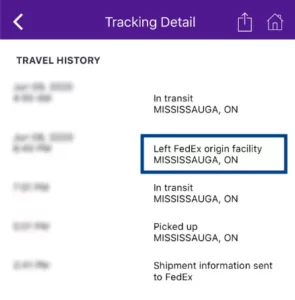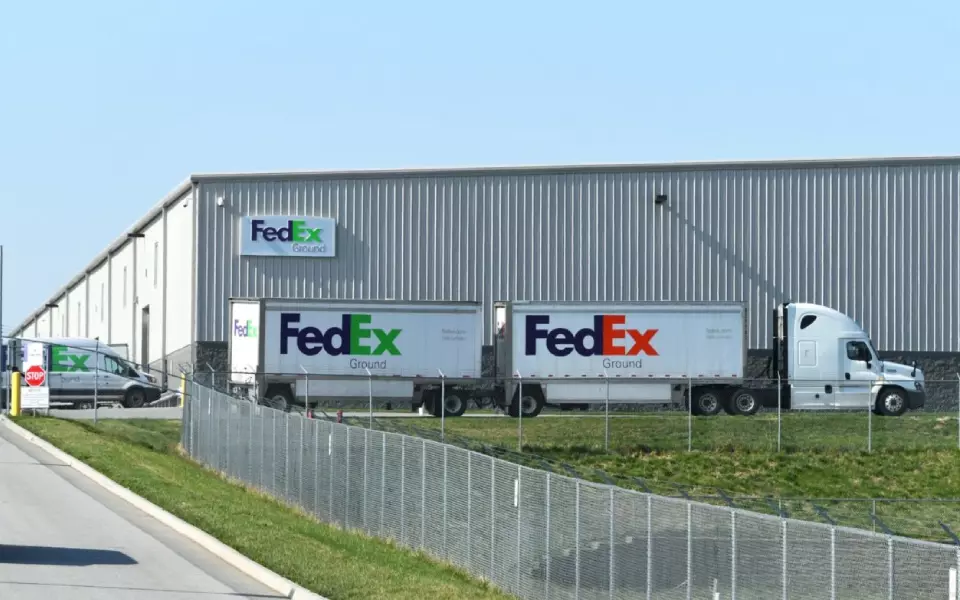FedEx is a renowned logistics company that delivers millions of packages each day. When you send a package through FedEx, the process often starts with either the sender dropping off the package at a FedEx location or a FedEx agent collecting it from the sender.
From there, the package is transported to a facility where it undergoes sorting and consolidation before embarking on its journey to the final destination. This facility is known as the “origin facility”, which is a consolidation warehouse where packages are scanned, processed, and dispatched.
Recipients will then notice that the status changes to “Left FedEx Origin Facility”, which indicates that the package is now sent through the FedEx network.
What Does This Status Mean?
When you come across the status “Left FedEx Origin Facility” your package has departed from the origin consolidation warehouse. This means that your package will now start its main transportation leg to the destination location.

At this stage, there’s no immediate action required from the sender or the recipient, as the package is handled by FedEx and is within its supply chain network. It’s also important to note that your package is still in the origin country.
To understand when your package will arrive, it’s best that you refer to the “Scheduled Delivery Time” indicator at the top of the tracking page, as it takes into account various factors like the package’s current location, the shipping method chosen, and any potential delays that may arise along the way.
What Is a FedEx Origin Facility?
A FedEx origin facility is a critical component of FedEx’s logistics infrastructure. These facilities are strategically located at various points across the country and around the world to efficiently manage the flow of packages from the point of origin to their final destinations.
FedEx origin facilities are essentially local warehouses or distribution centers that are logistics hubs, where packages are scanned in and processed, before heading on their main transport leg.

These facilities are owned and operated by FedEx, which means they have full control over their processes and operations. This ownership allows FedEx to maintain high standards of quality and efficiency throughout the shipping process.
One of the primary functions of a FedEx origin facility is to receive incoming packages. These packages are typically delivered to the facility by trucks, and upon arrival, they are scanned into FedEx’s inventory management system.
This step is crucial for tracking and locating packages within the facility’s extensive inventory. Upon arrival, packages are temporarily stored, before they are consolidated and prepared for shipment in an organized manner.
Activities Taking Place in FedEx’s Origin Facility
Several activities occur at FedEx’s origin facilities before packages are dispatched and prepared for their main transportation leg, which could be either a truck for domestic shipments or air freight for international shipments:
- Package Receiving – When packages arrive at the facility, they are delivered by trucks and scanned into FedEx’s inventory management system. This step ensures that FedEx can track and locate packages within its warehouse efficiently.
- Temporary Storage – Packages are temporarily stored within the warehouse until they are consolidated and prepared for shipment. Typically, they are dispatched on the same or the following day.
- Consolidation – Packages are then grouped and consolidated based on their final destinations. This process optimizes shipping efficiency by bundling packages heading to the same country, state, or city.
- Dispatching – After consolidation, packages are scheduled and loaded onto trucks. These trucks either deliver packages to another FedEx facility at the destination for domestic deliveries or transport them to an airport for international shipments.
Where is This Status in the Delivery Process?
The status “Left FedEx Origin Facility” is a common milestone in the shipping process and occurs after your package has been picked up by a FedEx agent or dropped off at a FedEx-authorized location.
At this point, the package is consolidated at a central distribution hub, which is the origin facility. The activities described earlier take place during this phase, ensuring that your package is prepared for its journey.
After Pickup/Drop-Off
Regardless of whether your package has been picked up by a dedicated FedEx agent or dropped off at one of FedEx’s authorized locations, they all share a common initial destination, which is the FedEx origin facility.
Once your package reaches the origin facility, it becomes part of a broader logistical process. As outlined earlier, they are received in the warehouse, temporarily stored, consolidated, and dispatched.
Before “In Transit”
Once the activities at the origin facility have been completed, you will receive another notification indicating that your package is now “In Transit”. This means your package is on its way to another facility for further processing.
For international shipments, this may involve customs clearance and distribution to one or more facilities within the destination country before the final delivery is made.
Can My Package Be Delayed After Receiving This Status?
While this status marks the beginning of your package’s journey, it’s important to understand that various factors can still affect its estimated time of arrival (ETA). These factors can include the following:
- Operational Issues – FedEx’s operations may encounter unexpected challenges or delays due to various reasons, such as staff shortages. This can impact the timely handling of packages and their movement through the network.
- Technical Issues – Technical glitches or malfunctions in tracking systems, inventory management systems, or equipment can lead to delays in package processing.
- Equipment Breakdown – Mechanical failures or breakdowns in vehicles or sorting equipment can disrupt the shipping process.
It’s essential to keep in mind that logistics is a complex operation, and unforeseen circumstances can occasionally affect delivery timelines. To obtain the most accurate information about your package’s delivery date, always refer to FedEx’s “Scheduled Delivery Time” indicated at the top of the tracking page.

Get Free Course Access
If you enjoyed the article, don’t miss out on our free supply chain courses that help you stay ahead in your industry.

Gerrit Poel
Co-Founder & Writer
at freightcourse
About the Author
Gerrit is a certified international supply chain management professional with 16 years of industry experience, having worked for one of the largest global freight forwarders.
As the co-founder of freightcourse, he’s committed to his passion for serving as a source of education and information on various supply chain topics.
Follow us